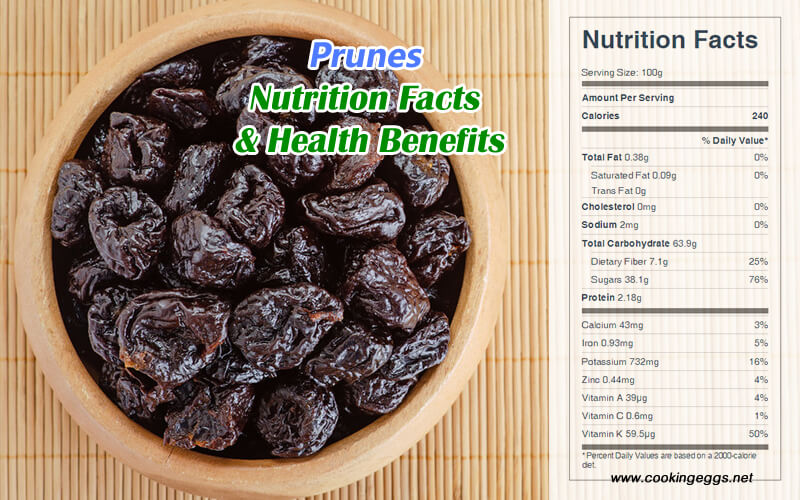Prunes Nutrition Facts & Health Benefits
A prune is a dried plum, most commonly from the European plum. Prunes and plums have a reputation as a remedy for digestive problems, but they are also a great contributor to our overall gut health and to maintaining a strong metabolism and immune system.

The nutritional value of Prunes
Prunes are 64% carbohydrates, including 7% dietary fiber, 31% water, 2% protein, a rich source of vitamin K (57% of the Daily Value, DV), and a moderate source of B vitamins and dietary minerals. Prunes are rich in anthocyanins as well as a good source of calcium, magnesium, potassium, vitamins A and C, lutein, and beta-carotene.
Five dried plums provide 100 calories, 26 g carbohydrate, 1.1 g protein, 0.2 g fat, 3 g dietary fiber, 834.5 IU vitamin A, 1.5 mg vitamin C, 0.8 mg niacin, 1.5 mcg folic acid, 313 mg potassium, 21.5 mg calcium, 1.5 mg sodium, 33 mg phosphorus, 1.04 mg iron, and 19 mg magnesium.
Prunes Nutrition Facts Label
Health Benefits of Prunes
Plums have numerous health benefits, including benefits for our bones and memory, as well as antioxidant and antiinflammatory properties. Prunes are dried plums, and they stimulate the digestive system. They are well known for their laxative effects; they are a natural remedy used to alleviate constipation.
Prunes are a significant source of the trace mineral boron, which is useful in converting calcium to bone and may play a role in preventing osteoporosis. Prunes have many of the same health benefits as plums, with more concentrated sugars and fiber due to the drying.
Prunes are rich in potassium, which helps with high blood pressure. Potassium has a major role in the maintenance of fluid and electrolyte balance. Diets low in potassium increase the risk of hypertension, stroke, and cardiovascular disease.
Prunes and prune juice contain phytochemicals, including phenolic compounds (mainly as neochlorogenic acids and chlorogenic acids) and sorbitol.
Prunes contain dietary fiber (about 7% of their weight), which may provide laxative effects. The sorbitol content of dietary fiber likely provides the laxative effect associated with consuming prunes. Prunes effectively contribute to the maintenance of normal bowel function in the general population if consumed in quantities of at least 100 grams per day.
The high fiber content in prunes explains their laxative effect, but it is a little more complex than that. Prunes also include the sugar alcohol sorbitol as well as phenolic compounds, chlorogenic acid, and neo-chlorogenic acids, which are not absorbed by the small intestine and go through the colon undigested, contributing to the laxative effect. Sorbitol acts as an osmotic agent, drawing water in. The fiber in prunes is made up of cellulose, hemicellulose, and pectin. These are classified into insoluble and soluble fibers.
The insoluble fibers (cellulose and hemicellulose) resist fermentation in the colon, increasing stool water, which leads to the digestive system constricting and contracting, thus creating movement. The pectin in prunes is fermented by the microflora in the colon, which produces short-chain fatty acids (SCFAs). These SCFAs are essential to our gut health as they are known to suppress the growth of bad bacteria by lowering intestinal pH as well as helping to regulate metabolism and the immune system.
Prunes contain hydroxyphenyl-isatin, which is a gentle, non-purging laxative. Most importantly, weight for weight, prunes are the most powerful of all the protective antioxidant foods. The US Department of Agriculture has calculated the ORAC (Oxygen Radical Absorbance Capacity) of prunes at 5770 units per 100 g, compared with 2,000-plus for raisins, blueberries, and blackberries. One handful of prunes provides more than the optimum protection of 5,000 ORACs daily.
Purple plums are high in anthocyanin content. Anthocyanins are flavonoids with free radical scavenging ability against reactive oxygen species. The major types of anthocyanins in plums are cyanidin and peonidin.
The phenolic compound, chlorogenic acid, also has a huge effect on the gut. Chlorogenic acid gets metabolized in the colon by the microbiota and forms the by-product caffeic acid, which has been shown to stimulate Bifidobacterium. Bifidobacterium species play a critical role in regulating our immune system. This genus of probiotics increases T regulatory cells, which we know helps to balance our immune system.